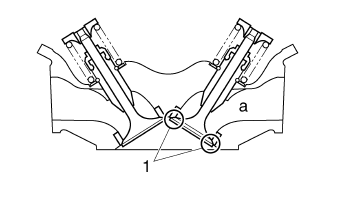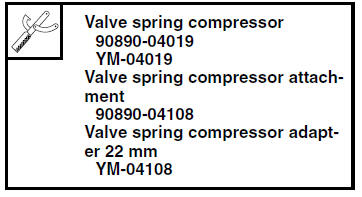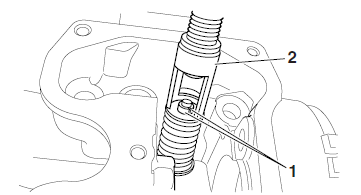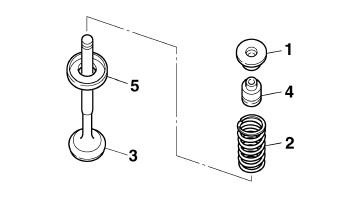Yamaha YZF-R125 Service Manual: Removing the valves
The following procedure applies to all of the valves and related components.
NOTE:
Before removing the internal parts of the cylinder head (e.g., valves, valve springs, valve seats), make sure the valves properly seal.
1. Check:
- Valve sealing
Leakage at the valve seat
 Check
Check
the valve face, valve seat, and valve seat width.Refer to "CHECKING THE VALVE SEATS" on page 5-20.
a. Pour a clean solvent "a" into the intake and exhaust ports.
b. Check that the valves properly seal.
NOTE:
There should be no leakage at the valve seat "1".

2. Remove:
- Valve cotters "1"
NOTE:
Remove the valve cotters by compressing the
valve spring with the valve spring compressor
and the valve spring compressor attachment "2".

3. Remove:
- Upper spring seat "1"
- Valve spring "2"
- Valve "3"
- Valve stem seal "4"
- Lower spring seat "5"
NOTE:
Identify the position of each part very carefully so that it can be reinstalled in its original place.

 Checking the valves and valve guides
Checking the valves and valve guides
The following procedure applies to all of the
valves and valve guides.
1. Measure:
Valve-stem-to-valve-guide clearance
Out of specification Replace the
valve
guide.
Valve-stem-to-valve ...
Other materials:
Checking the valve seats
The following procedure applies to all of the
valves and valve seats.
1. Eliminate:
Carbon deposits
(from the valve face and valve seat)
2. Check:
Valve seat
Pitting/wear Replace the
cylinder head.
3. Measure:
Valve seat width C "a"
Out of specification Replace
the ...
Owner's tool kit
Owner's tool kit
Owner's tool kit
Engine oil drain attachment
The owner's tool kit is located under the
rider seat.
The service information included in this
manual and the tools provided in the
owner's tool kit are intended to assist
you in the performance of preventive
maint ...
Installing the radiator
1. Fill:
Cooling system
(with the specified amount of the recommended
coolant)
Refer to "CHANGING THE COOLANT" on
page 3-15.
2. Check:
Cooling system
Leaks Repair or replace any
faulty part.
3. Measure:
Radiator cap opening pressure
Below the specified pressure Repla ...

